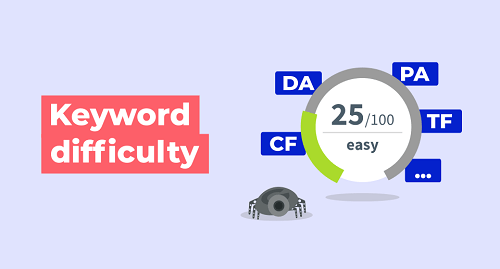Keyword Difficulty and SEO
 Search volume is often a more prestigious metric in a world that values numbers more than keyword difficulty. Despite knowing how many times your keyword is entered as a query in a given month, it is just as crucial to understanding the level of competition vying to rank highly for that keyword. Using a keyword research tool, you can create organic content by finding a term with a high search volume that has a low keyword difficulty level.
Search volume is often a more prestigious metric in a world that values numbers more than keyword difficulty. Despite knowing how many times your keyword is entered as a query in a given month, it is just as crucial to understanding the level of competition vying to rank highly for that keyword. Using a keyword research tool, you can create organic content by finding a term with a high search volume that has a low keyword difficulty level.
What is Keyword Difficulty?
The keyword difficulty metric (also known as keyword competition or SEO difficulty) measures the difficulty of ranking for a given keyword. Because the ranking websites are usually highly competitive, ranking on the first page of the SERPs becomes increasingly difficult, and the keyword’s difficulty increases. The quality of your page and the competitors’ pages are just a few factors that influence the keyword difficulty.
Why is Keyword Difficulty Important?
In SEO, keyword difficulty primarily refers to the number and quality of backlinks to the top ten pages in the Search Engine Results Page (SERP) for the keyword—or how competitive those pages are based on how many backlinks they have.
Search engine optimization keyword tools gauge the “competitiveness” of a SERP by looking at the domain authority (or domain rating) and page authority (or URL rating) of the indexed pages. Backlinks assign a score to each website ranking in the top SERP for its search engine. That score will tell you how difficult it is to break into the 1st SERP for that keyword.
By keeping track of keyword difficulty:
- You’ll get a broad overview of what the “hot” keywords and “big” players in your market are.
- You’ll be able to identify alternative keywords in your market that you have a reasonable chance of ranking.
- Even if your website doesn’t yet have much authority, you can save time by focusing on keywords that can bring you results.
How to Find the Right Keyword
If you want to estimate how hard it will be for you to rank for a certain keyword, you need to consider both internal and external factors. Which are:
Your competitors
Outranking your competitors is the key to SEO. The best way to assess the difficulty of ranking for a keyword is to look at the competing websites. The following are important factors to consider:
- content quality
- on-page optimization
- backlinks
A keyword’s ranking difficulty can be estimated well by looking at the backlinks since they are still important. Furthermore, it is the only factor that can be measured and quantified. That’s why estimating keyword difficulty usually boils down to finding out how authoritative (as determined by the link profile) your competitors are. You will have a harder time outranking websites ranking for a keyword with more authority.
The Authority of your Website
In addition to your competitors, your own website’s authority is an important factor in ranking for a keyword. You should keep this in mind if you have just created your new website. With a brand new site and no backlinks, you may not rank with a keyword even if the competition is relatively low.
The Quality of your Content
However, there’s another side to the coin – if your content isn’t good enough to compete with those ranking in the 1st SERP, even having an authority website won’t help. Here are some questions you should ask yourself:
- What is the likelihood I will produce content that is equal or better in quality than my competitors?
- How do I measure up to my competitors’ expertise?
- Is there anything I can offer readers that they cannot get from my competitors? This includes quality, unique data, visuals, and depth of knowledge.
The total amount of difficulty of your keyword search will depend on all these subjective factors.
Search Intent
In addition to considering the search intent, you should also consider the search phrase. In other words, what kind of content do people who have used a particular keyword expect? Search intent can be divided into four main categories:
- Navigational
- Informational
- Transactional
- Commercial
How can you determine what the search intent is behind a keyword? By looking at the search results for the keyword, you can “reverse engineer” it to see what kind of pages rank for it. You most likely won’t rank for that keyword with your e-commerce landing page if your keyword is “best air humidifier” and all the results on the 1st SERP are reviews. The content of your website would be better optimized even if your site were more authoritative.
Ahref’s Keyword Difficulty Metric
Ahrefs measures Keyword Difficulty by looking at the search results for a keyword and counting how many domains refer to the top 10 ranking pages. Keyword Difficulty has a direct relationship with the number of referring domains across the top-ranking pages. However, Ahref’s Keyword Difficulty metric does not take on-page factors into account.
Keyword Difficulty Scale from Ahrefs
A keyword’s difficulty is measured on a scale from 0 to 100, where 100 is the most difficult. There is no linear scale. The values on the graph correspond to the estimated number of referring domains (RDs) a page needs to get to the first page of search results. To make it into the top 10 search results for a KD 40 keyword, you need approximately 56 RDs.
Keyword Difficulty Overview
By combining this metric with Search Volume, you will be able to identify keywords that will bring you a lot of organic traffic without requiring too much effort to rank for. Despite its importance, Keyword Difficulty should not be your sole consideration when selecting keywords. It is recommended to use it as the first filter to sort through the many possible keywords. Choosing the next keywords must be based on comprehensive keyword research.



